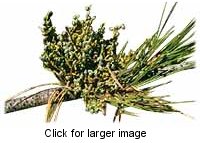
|
The Celtic Origins of Mistletoe (Viscaceae) also known as Allheal or Golden Bough In Victorian times, kissing under the Mistletoe was a Christmas ritual that old-timers hoped would lead to romance and marriage among the younger generation. Today, the Mistletoe is familiar to us as a Christmas decoration that results in some innocent mischief at the annual Christmas office party. But in ancient times, the Mistletoe was known by the Celts and the Vikings as a healing plant upon which superstition and myth had bestowed miraculous healing powers.
Mistletoe is a aerial parasitic plant that grows high in the boughs of trees. The Mistletoe does not have roots and is dependent on its host for survival.
Although it is mainly associated with Oak trees in Celtic mythology, the European variety grows on deciduous trees. The Latin name for American mistletoe, Phoradendron serotinum, means "Phora" - Greek for thief, and "dendron" - for tree, in reference to the fact that mistletoe sends its roots into the host tree, robbing it of nutrients.
Mistletoe is propagated primarily by birds who deposit the berries during flight. These berries quickly root in their new home and in some places, trees are green in winter from the Mistletoe they host. Celtic Myth
In the Celtic language, Mistletoe means "All Heal". The ancient Celts believed Mistletoe possessed miraculous healing powers and held the soul of the host tree. According to Francis X. Weiser, in his Handbook of Christian Feasts and Customs:
Viking Myth
Viking beliefs of Mistletoe's powers were rooted in the myth of the resurrection of Balder, the god of the summer sun. As the story goes, Balder had a dream in which he dies. The dream alarmed his mother, Frigga, the Goddess of Love and Beauty, for if Balder died, so too would all life on earth. Frigga went to all the elements, air, fire, water and earth as well as all the animals and plants on earth and asked them to spare her son. Satisfied that she had secured the cooperation of all, Frigga assured Balder that he would live forever. But Balder had one enemy, Loki, God of Evil, and Loki found one plant that Frigga had overlooked - Mistletoe. Mistletoe grows neither on the ground or under the ground - rather, it is an aerial parasite that has no roots of its own and attaches itself to the tree it grows on.
Loki made a poisoned arrow tip with the Mistletoe and tricked Balder's blind brother, Hoder, into shooting the arrow and killing Balder. For three days, the earth grew dark and the skies poured rain. Each of the elements in turn, tried to bring Balder back to life, but none were successful save for Frigga, his loving mother. Legend says that the tears she shed during those terrible three days turned into the white berries on the Mistletoe plant. In her joy at Balder's resurrection, she reversed Mistletoe's poisonous reputation, kissed everyone who passed beneath the tree on which it grew and issued a decree that should one ever pass beneath the Mistletoe, they should have a token kiss and no harm would befall them. Christianity
When Christianity took a foothold in the Celtic and Viking regions of northern Europe, the ancient ways were condemned as pagan practises and were abandoned by the newly converted. Mistletoe was one of the casualties, and for centuries it was forbidden to display the plant on Christian altars. Eventually, Mistletoe found its way back into acceptance as the Victorians revived the ancient ritual of kissing under the Mistletoe as a sign of love, romance and good luck.
Today, Mistletoe can be purchased at most flower shops and even some grocery stores at Christmas. And although we may not hold the same spiritual beliefs as the ancient Norseman and the Celts, we can always remember the good will and happiness it represents with a kiss under the Mistletoe this season.
MMJ, December, 1999
MORE Celtic Christmas Stories:
The Celtic Origins of Mistletoe
The Celtic Origins of Christmas: Alban Arthuan
Links
More Mistletoe from the Herbal Sage
Handbook of Christian Feasts and Customs |
Thursday, December 26th, 2019
Attention visitors: Tartans.com is back. Please note that this is a snapshot of the site as it existed nearly 20 years ago and you may encounter broken links; we are still combing through the site and correcting those as we find them. Please also note that some sections are currently not functional, primarily the discussion forums/clan chat boards.
|
** HOME - First Time Visitors - Glossary - - Contact Us ** Awards | Bibliography | Clan Calendar | Clan Chat | Clan Finder | History | Famous Scots | Genealogy | Great Hall of the Clans | Links | News and Features | Scots on the Net | Search | Site Map The Gathering of the Clans
Copyright 1995- Tartans.com - All Rights Reserved. |

 In ancient times, the Druids held a special ceremony five days after the new moon following the Winter Solstice, in which they cut the boughs of the Mistletoe from the sacred Oak tree with a golden sickle. It was important that branches did not touch the ground and become contaminated. Then the priests divided up the boughs into sprigs and distributed them among the people who believed the Mistletoe protected them from storms and evil spirits.
In ancient times, the Druids held a special ceremony five days after the new moon following the Winter Solstice, in which they cut the boughs of the Mistletoe from the sacred Oak tree with a golden sickle. It was important that branches did not touch the ground and become contaminated. Then the priests divided up the boughs into sprigs and distributed them among the people who believed the Mistletoe protected them from storms and evil spirits.